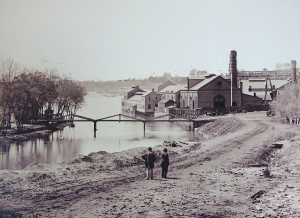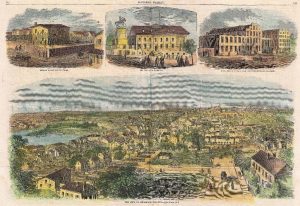Richmond Rising: African Americans and the Mobilization of the Confederate Capital
ECW welcomes guest author Cameron Sauers
The idealistic fervor of young soldier boys marching off to war is contagious even for modern readers who cannot help but find something gallant in April 1861. But lurking beneath the surface of romantic scenes off the march to war is the realization that mobilizing for war would tax labor systems to their stretching point. In Confederate Richmond, mobilizing for war meant the increased exploitation of enslaved laborers and conscription of the labor of free African Americans. On the eve of the war, Richmond had nearly 12,000 slaves and 2,500 free blacks, all of whom would eventually be forced into wartime labor. In contrast to the plantation where the enslaved were owned by individuals, hundreds of blacks in Richmond were owned by the city government and by manufacturers, such as the Tredegar Iron Works.[1] Incorporation of the labor of black men and women in the mobilization for war provides a fuller picture of the march to war in the spring and summer of 1861.

As the Confederate capitol rushed to prepare for war, many of its citizens and organizations rushed to acquire enslaved laborers. As a Southern transportation hub, Richmond had a sizable market for the buying and selling of the enslaved.[2] One advertiser in the Richmond Enquirer was hoping to make a large business deal: “$15,000 worth of dry goods in exchange for Negroes.”[3] Considering that the average sale price for the most in-demand category of a slave, young middle-aged men, was $792, this would be an extraordinarily large business deal.[4] Even larger was the $30,000 appropriated by the Richmond municipal government for the purchase of enslaved laborers to maintain the municipal gas works.[5] The black population had swelled during this period as the collapse of Virginia’s tobacco market made available thousands of enslaved laborers, while some slave-owners sent their slaves to Richmond for “safe-keeping.” As evidence of the extent of the demand for black labor, Tredegar Iron Works nearly doubled its black labor force from its prewar size of 80 to 135 by January 1862 – most of them enslaved men.[6] Tredegar would be the single most valuable industrial plant in the Confederacy, producing 1,600 siege pieces, armor for ironclads, and hundreds of thousands of artillery shells.[7] In the production of arms for the Confederacy, labor performed by African Americans would be invaluable.
As its armies marched to war, Confederate soldiers also acquired enslaved men to accompany them. Believing that all slaves were docile and would remain loyal, officers brought military age enslaved men to serve as manservants or cooks. Some masters even outfitted their slaves in Confederate grey, which attempted to encourage the enslaved to “support and identify with the Confederate cause.”[8] As historian Kevin Levin notes “the presence of large numbers of slaves in camp not only served as reminders of home and helped to ease the transition from civilian to military life for their owners but also helped to define a slaveholding community at war.”[9] Though allowing black men to fight would crumple Southern racial ideologies, white Southerners attempted to instill into free and enslaved blacks a sense of duty to the Confederate nation.[10] Print media allowed for the dissemination of stories that validated black loyalty to the Confederacy, thus assuaging Southern fears that the enslaved would strike for freedom during their war. In the aftermath of First Manassas, the Richmond Enquirer reported that a slave, with a gun on each shoulder, marched a wounded Zouave into camp before exclaiming “Massa, here one of the devils who been shooting at us, sir.”[11] The semantics of this simple sentence reveals the complex dynamic between master and slave. The slave addressed a white man as “Massa”, with no indication given that the officer present is his owner. Similarly, the slave remains mindful of the gulf between white and black by closing the sentence with “sir.” However, that gap disappears when the slave addresses that the soldier had been shooting at “us”, meaning the slave and his master. Each newspaper story, whether real or imagined, reported to Southerners seemed to vindicate their belief in the fidelity of the slaves, despite there being just as many – if not more – advertisements from masters fearing that their slaves “may have taken a more direct route to the enemy”[12] as A.N. Bernard of Fredericksburg published in the Enquirer hoping futility that his slaves would return.[13] Confederate armies on the battlefield relied on enslaved men to perform basic, but necessary, tasks, while also constructing narratives about the enslaved to reinforce the South’s racial ideology.
Enslaved and free African Americans played a significant role in Richmond’s development of infrastructure to support the military. As the white male labor pooled evaporated due to conscription, railroads and hospitals increasingly relied on the labor of both black men and women. Ernest Ferguson notes that as the “capital, military headquarters, transportation hub, industrial heart, prison, and hospital center of the Confederacy” black labor was a necessity nearly always in shortage, especially as an increasing number of slaves escaped to freedom or were already involved in war work. The immediate need for black labor was first revealed in the aftermath of First Manassas as there was an insufficient number of hospital attendants could be found, leading to urgent advertisements in the Richmond Enquirer posted an urgent advertisement on July 29th requesting “servants” to aid for the wounded and sick. The advertisers added their hopes that the labor would be provided at no cost, thereby expecting the slaveowner to put patriotism over profit.[14] Despite consistent advertisements and requests for masters to loan their slaves to municipal operations, masters proved unwilling to part with their slaves, not unwisely fearing loss of their investment in human property. Caring for the wounded was a task that could be performed by both black men and women, so when patriotic appeals failed, outright impressment could be utilized.

Impressment forced both enslaved and free black and women into necessary wartime work. One of Richmond’s largest hospitals, Chimborazo, used impressment to acquire some of the 400 black men and women who worked in Chimborazo hospital by 1863.[15] Chimborazo, like most of wartime Richmond’s hospitals, did not exist at the start of the war and relied on the labor of free and enslaved black men and women, as well as available white women. The impressment of black male labor began formally in February 1862, but as early as July 1861, the mayor of Richmond ordered two freed blacks, Thomas Logan and William Roberts, and an unnamed slave conscripted into labor.[16] When black labor could not be acquired willingly, whether by masters’ approval or by hire, African Americans would be impressed to support the Southern war effort.
The city of Richmond relied on the labor of enslaved men and women to operate in its different roles as capitol city and military hub. At the same time as romantic images of young men marching off to battle, the system of slavery was being mobilized to its maximum to provide the labor needed to increase the city’s industrial output, while also accounting for black bodies diverted away to accompany masters into battle and nurse wounded soldiers in the city’s hospitals. Richmond’s system of slavery once made Charles Dickens write “with a grateful heart that I was not doomed to live where slavery was, and had never had my senses blunted to its wrongs and horrors in a slave rocked cradle”[17] demonstrating just how cruel and brutal urbanized slavery could be. More than just the enslaved suffered, as free blacks, especially men, in Richmond were stripped of their freedom and impressed into laboring for a nation founded upon their subjugation.
Cameron Sauers is a member of the Gettysburg College class of 2021 where he is a History major with minors in Public History and Civil War Era Studies. Cameron is a Fellow at the Civil War Institute and regularly writes for their blog, the Gettysburg Compiler. Cameron has also written for various digital history projects and the blog of the National Museum of Civil War Medicine. Cameron is currently co-Editor in chief of The Gettysburg College Journal of the Civil War Era, the nation’s only undergraduate Civil War journal. Through Gettysburg College’s Brian C. Pohanka internship program, Cameron has interned in the education department at Harpers Ferry National Historical Park. Cameron can be found on twitter @Cam_Sauers.
Sources:
[1] Ernest Ferguson, Ashes of Glory: Richmond at War. (New York: Knopf, 1996) 18
[2] Stephen Ash, Rebel Richmond: Life and Death in the Confederate Capitol. (Chapel Hill: UNC Press, 2019), 7.
[3] Richmond Enquirer, July 01, 1861, p.6.
[4] Daina Ramsey Berry, The Price for Their Pound of Flesh: The Value of the Enslaved from Womb to Grave in the Building of a Nation. (Boston: Beacon Press, 2017), 91.
[5] Ash, Rebel Richmond, 92.
[6] Ash, Rebel Richmond, 84.
[7] Ferguson, Ashes of Glory, 65.
[8] Ash, Rebel Richmond, 21. Kevin Levin, Searching for Black Confederate: The Civil War’s Most Persistent Myth. (Chapel Hill: UNC Press, 2019), 29.
[9] Levin, Searching for Black Confederates, 19.
[10] Levin, Searching for Black Confederates, 40. Ferguson, Ashes of Glory, 69.
[11] Richmond Enquirer, July 25, 1861, p.3
[12] Richmond Enquirer, July 25, 1861, p.6
[13] Randall C. Jimerson, “The Test of Slaves Loyalty” in The Confederate Experience Reader: Selected Documents & Essays, ed. John D. Fowler, (New York: Routledge, Taylor & Francis Group, 2008), 302.
[14] Richmond Enquirer, July 29, 1861, p.3
[15] Ash, Rebel Richmond, 92.
[16] Richmond Enquirer, July 12, 1861, p.6
[17] Ferguson, Ashes of Glory, 20.
Excellent article, thank you!
Thank you so much!
Fascinating post.
Cameron, are there any statistics on the death rates of enslaved workers at the Tredegar Works? I bet they were high.
Bob,
Not that I have seen, but I would be fascinated to see them if they do exist. One of the challenges is the sparse documentation of African American’s actual roles at the plants. Anne Kelly Knowles wrote an article “Labor, Race and Technology in the Confederate Iron Industry.” Technology and Culture 42, no.1 – January 2001 (it should be available online for free) that is a fascinating look at racial ideologies and the operation of plants like Tredegar.
Thank you for reading!
Great article, Cameron!
Thank you Mr. Mackey!
It is great to see some one of your generation taking up the interest in this our country’s period of history and in doing so wrote an extensive researched article . One that shows the facts with out bias. Thus allowing the reader to form his own opinion of the times then 1860 and not 2020
Thank you Cameron for this excellent article . and your devotion to the history of our country ..
What was the progression of impressment of free blacks in Virginia in the legislature? Were they aware of what the legislature was planning? Did any free blacks leave Virginia, or were they allowed to prior to impressment?